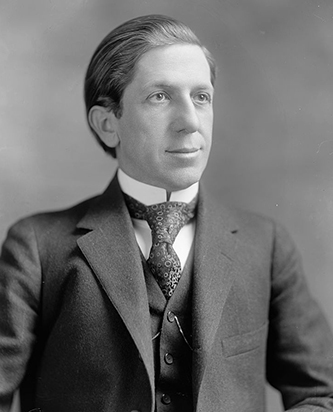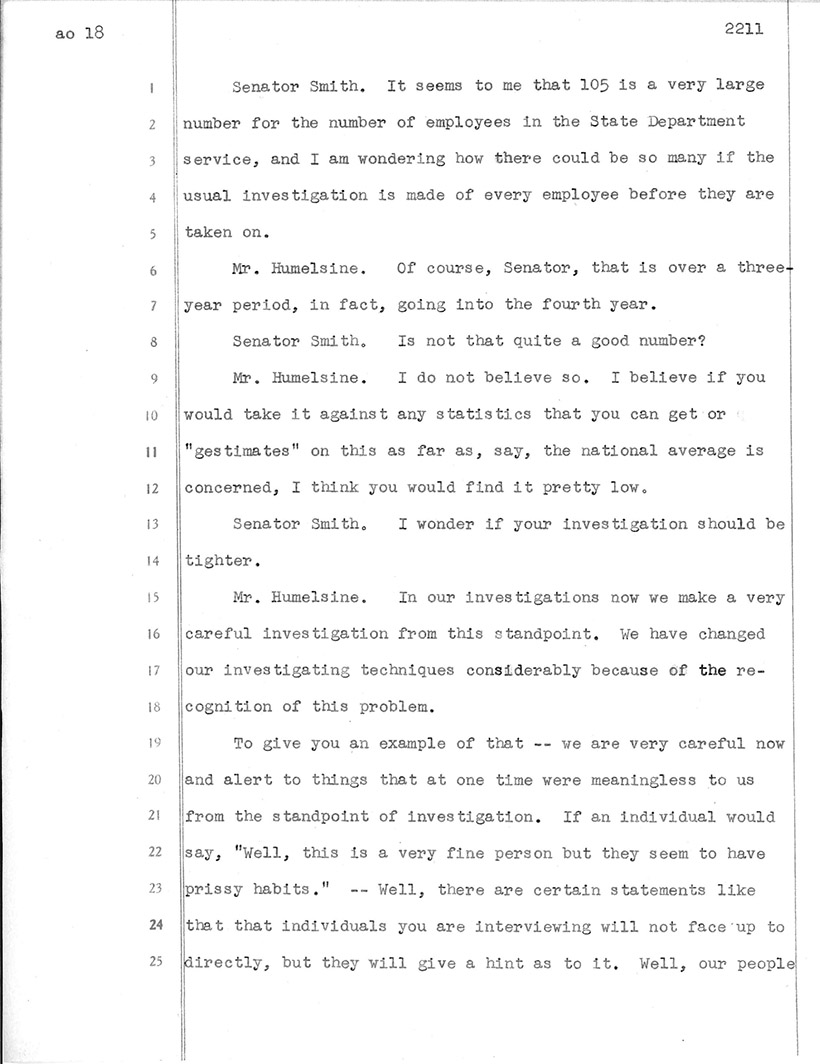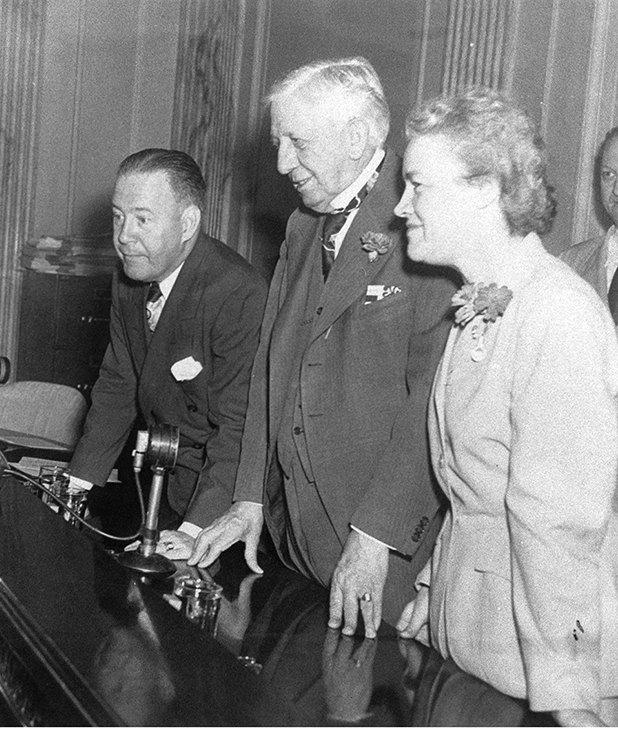The Lavender Scare was a moral panic that spread throughout the United States primarily after World War II. The Lavender Scare was related to the national Red Scare, but its subject was gay and lesbian Americans rather than Communists. The belief put forth was that their "immoral lifestyle” made them more likely to be "subject to foreign espionage" (or spying). The Lavender Scare led to mass firings and discrimination against gay and lesbian Americans posing as a matter of “national security.” The Lavender Scare also had close connections to North Carolina.
Prominent North Carolinians who were involved in the Scare were Josephus Daniels, Clyde Hoey, and James Webb. Josephus Daniels, along with future president Franklin Roosevelt, was involved with the 1919 Newport Scandal. It promoted fears about gay men in the government and military. Clyde Hoey led the 1950 Hoey Committee. It investigated people in the United States government suspected of being gay. The Committee’s findings informed many of the actions of United States presidents during the Lavender Scare. James Webb oversaw two government departments, the Department of State (1949-1952) and NASA (1961-1968). During the height of the Lavender Scare, each of these organizations fired many gay employees. Though unlikely, it remains unclear whether Webb had any role in the firings.
Discrimination began to take large-scale effect during Roosevelt’s presidency. It grew to its most significant periods during the presidencies of Truman and Eisenhower. According to the White House, 5,000-10,000 people were fired or resigned from employment in the federal government as a result of the Lavender Scare. Between 1947 and 1961, more people were fired for their orientation than for their associations with the Communist Party. People who were interrogated and fired as part of the Lavender Scare also often died by suicide.
Echoes of the Lavender Scare can still be felt across our society today. This ongoing debate spans all government levels, from local city councils to the federal government. As of May 2023, over 520 different pieces of legislation (along with seventy new laws) have been issued across the United States, including North Carolina. Resources like information and medical care of LGBTQIA+ Americans are the primary targets of the new legislation.
Glossary:
Discrimination: to treat someone differently, usually unfairly. Common forms of discrimination include race, sex, sexuality, religion, age, and ability.
Guided Reading Questions:
- Why were people targeted during the Lavender Scare?
- Name one North Carolinian who was involved in the Lavender Scare. What did they do?
- Name one president who was involved in the Lavender Scare.
References:
Adkins, J. "These People are Frightened to Death." National Archives and Records Administration. https://www.archives.gov/publications/prologue/2016/summer/lavender.html (accessed August 9, 2023).
Blakemore, E. "How LGBT Civil Servants Became Public Enemy No. 1 in the 1950s." HISTORY. https://www.history.com/news/state-department-gay-employees-outed-fired-... (accessed August 9, 2023).
"Cold War, Lavender Scare, and LGBTQ+ Activism." National Park Service. https://www.nps.gov/articles/000/cold-war-lavender-scare-and-lgbtq-activ... (accessed August 9, 2023)
“DANIELS AND ROOSEVELT CONDEMNED BY COMMITTEE WITHOUT HEARING THEM.” Salisbury Evening Post (Salisbury, N.C.), July 19, 1921. https://newspapers.digitalnc.org/lccn/sn88074850/1921-07-19/ed-1/seq-1/ (accessed August 9, 2023).
"Different fight, 'same goal': How the Black freedom movement inspired early gay activists." NBC News. https://www.nbcnews.com/feature/nbc-out/different-fight-same-goal-how-bl... (accessed August 9 2023).
"LGBTQ+ Government Workers." Library of Congress. https://guides.loc.gov/lgbtq-studies/subject/government-workers (accessed August 9, 2023).
"Milestones in the American Gay Rights Movement." Public Broadcast Station. https://www.pbs.org/wgbh/americanexperience/features/stonewall-milestone... (accessed on August 9, 2023).
Odom, Brian C. PhD, MLIS. “NASA Historical Investigation into James E. Webb’s Relationship to the Lavender Scare: Final Report.” 2022.
Owens, Erin. "The Lavender Scare: How Fear and Prejudice Impacted a Nation in Crisis." Armstrong Undergraduate Journal of History, vol 10, no 2, Article 8. Statesboro, GA: Georgia Southern University, 2020. https://digitalcommons.georgiasouthern.edu/cgi/viewcontent.cgi?article=1... (accessed on August 9, 2023).
Pruitt, S. "Once Banned, Then Silenced: How Clinton’s ‘Don’t Ask, Don’t Tell’ Policy Affected LGBTQ Military." HISTORY. https://www.history.com/news/dont-ask-dont-tell-repeal-compromise (accessed on August 9, 2023).
“SENATE COMMITTEE ROASTS ROOSEVELT AND SEC. DANIELS.” The Wilson Times (Wilson, N.C.), July 22, 1921. https://newspapers.digitalnc.org/lccn/sn92073953/1921-07-22/ed-1/seq-7/ (accessed August 9, 2023).
Sopelsa, Brooke. "Justice Department Ordered to Release 1950s Gay 'Purge' Documents." NBC News. August 3, 2017. https://www.nbcnews.com/feature/nbc-out/court-tells-justice-department-r... (accessed on August 9, 2023).
Wills, Matthew. "The Lavender Scare." JSTOR Daily. November 18, 2019. https://daily.jstor.org/the-lavender-scare/ (accessed on August 9, 2023).
Additional Resources:
Federman, Peter Stanley, & Nicole M. Rishel Elias. “Beyond the Lavender Scare: LGBT and Heterosexual Employees in the Federal Workplace.” Public Integrity, vol 19, no 1, 22–40. Washington, D.C: American Society for Public Administration, July 29, 2016. https://doi.org/10.1080/10999922.2016.1200410 (accessed on August 9, 2023).
Robinson, Brandon Andrew. "THE LAVENDER SCARE IN HOMONORMATIVE TIMES: Policing, Hyper-incarceration, and LGBTQ Youth Homelessness." Gender & Society, vol 34, no 2, 210–232. Riverside, CA: University of California, Riverside: April 2020. https://journals.sagepub.com/doi/pdf/10.1177/0891243220906172 (accessed on August 9, 2023).
"Series: Pride Through the Decades." National Park Service. https://www.nps.gov/articles/series.htm?id=98A2D50F-DAEE-43A1-6022C0F289... (accessed on August 9, 2023).


